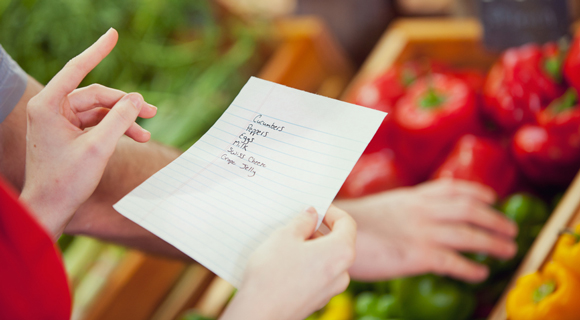
Healthy eating: Making healthy choices when you shop
Healthy eating starts with smart food shopping. Here you will find pointers on how to make the most of your trip to the grocery store. Whether you want to eat healthier or lose weight, these tips will help you get started.
- Plan ahead. Before you shop, decide on the meals and snacks you want. Think about how much time you have to prepare your meals, and then choose recipes that fit that time frame. For example, you may need to make most of your meals in less than 20 minutes, but maybe you have time to make one recipe that takes longer. When you decide on your menu, check to see which items you already have. Then make a list of the ingredients you will need to buy at the store.
- Don’t shop when you are hungry. Eat a snack or a meal before you shop. This way you won’t be as tempted to buy less healthy ready-to-eat foods, such as candy, chips, or fast food, to satisfy your hunger.
- Buy smart, and be realistic. Include some healthy snack foods and special treats on your shopping list. Remember to include some healthy convenience foods, such as cut-up, bagged, fresh vegetables or lower-calorie or lower-sodium frozen foods.
- Shop healthy. At the store, use the shopping list you created from your menu plan. You may notice that the items on the outer aisles of the store are mostly fresh foods, such as meat, produce, and dairy. As you shop, pay attention to how much you buy from the outer aisles compared to the inner aisles where you find the more processed foods, such as canned soups, packaged cookies, chips, and soda.
How can you make the most of your shopping trip?
At the store
Use the shopping list you created from your menu plan. You may notice that most of the items on the outer aisles of the store are fresh foods, such as meat, produce, and dairy. These items tend to be less processed compared to some of the foods in the center aisles, such as packaged cookies, chips, or soda. As you shop, pay attention to how much you buy from the outer aisles compared to the inner aisles where the processed foods are.
What to buy
When you are selecting items from your list, try to choose foods lower in fat, calories, and/or sodium if possible. For example, when you buy sandwich meat, remember that plain roast turkey or roast beef has much less fat and sodium than processed lunch meat. You can also buy fat-free or low-fat dairy items, such as milk, yogurt, and cheese.
Try to limit drinks with added sugar, such as soda and sweetened iced tea. Instead, try to drink more water or buy sugar-free drinks or drinks with little or no added sugar.
Include some healthy convenience foods on your shopping list for both meals and snacks. These are great to have on hand if you are busy or don’t like to cook. You may want to try:
- Bagged, precut vegetables or salad greens that you can either steam to have with dinner or eat raw as a snack.
- Healthy frozen entrees that are lower in fat, calories, and/or sodium. You can use these on days when you don’t have time to prepare a meal. Add a salad or fruit and a glass of milk to round out this meal.
- Trail mix with nuts and dried fruit. In small portions, this makes a healthy, satisfying snack.
- Fruits, such as apples, grapes, or oranges, that are ready to eat after you wash them.
- Low-fat string cheese with whole-grain crackers or fruit.
- Individual-size yogurt or applesauce.
Helpful hints
Try to buy just what’s on your shopping list as much as possible. Sale items may seem like a good bargain. But if you weren’t planning on buying them in the first place, they may not be a good deal.
Portion size is also an important part of healthy eating. Whether you are shopping for yourself or a family, you can buy certain things in bulk. For example, if you buy a large “family pack” of chicken, you can divide it into single-meal portions and freeze them. This is a good way to control how much you eat at each meal and have a quick option available when you don’t have time to go to the store.
Keep in mind that if you are shopping for one, not everything is good to buy in bulk quantities. Fresh produce and other perishables in large amounts may not last long enough for one person to eat them all.
Current as of: November 14, 2014
Author: Healthwise Staff
Medical Review: Kathleen Romito, MD – Family Medicine & Rhonda O’Brien, MS, RD, CDE – Certified Diabetes Educator
This information does not replace the advice of a doctor. Healthwise, Incorporated disclaims any warranty or liability for your use of this information. Your use of this information means that you agree to the Terms of Use. How this information was developedto help you make better health decisions.
To learn more, visit Healthwise.org
© 1995-2015 Healthwise, Incorporated. Healthwise, Healthwise for every health decision, and the Healthwise logo are trademarks of Healthwise, Incorporated.





